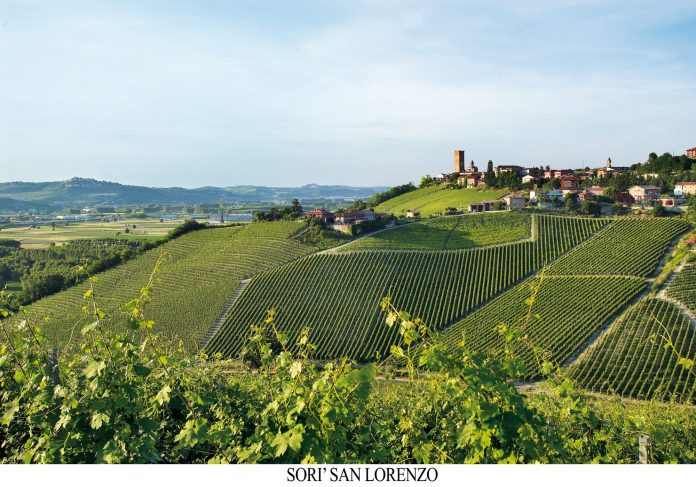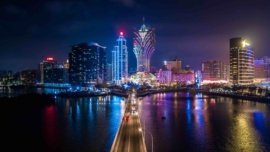By: Luis Antunes
When you see Angelo Gaja (b. 1940) on a communication offensive, it’s easy to understand how, when he joined his father Giovanni to oversee the Gaja house in 1961, nothing could stay as it was. A born communicator with an extraordinary dynamic, Angelo can make the unique link between the Barbaresco contadino, a country-dweller tied to the land, to family and traditions, and the elegant globetrotter with a designer tie who wins awards for himself and his wines in New York or London.
 The Gaja house was founded in 1859, but it was in the last 55 years that it stopped using a local name to project Italian wines, and within those, the wines of Piedmont, as the most desired and prestigious in the world. The changes happened gradually. A revolutionary but at the same time moderate, Angelo knows how to drive motion, but he also knows how to wait for the results. In this way, he was the first to dare age his Barbaresco Nebbiolos in new French oak casks (in 1969, as opposed to the traditional large seasoned Slovenian oak barrels), kicking off huge controversy between traditionalists and innovators that lasted two decades. He solved it, quite simply, with a centrist position. Today, he ages his wine for 12 months in new casks and another 12 in seasoned barrels.
The Gaja house was founded in 1859, but it was in the last 55 years that it stopped using a local name to project Italian wines, and within those, the wines of Piedmont, as the most desired and prestigious in the world. The changes happened gradually. A revolutionary but at the same time moderate, Angelo knows how to drive motion, but he also knows how to wait for the results. In this way, he was the first to dare age his Barbaresco Nebbiolos in new French oak casks (in 1969, as opposed to the traditional large seasoned Slovenian oak barrels), kicking off huge controversy between traditionalists and innovators that lasted two decades. He solved it, quite simply, with a centrist position. Today, he ages his wine for 12 months in new casks and another 12 in seasoned barrels.



 The fourth in the Gaja lineage at the helm of the house’s fate (after his great-grandfather Giovanni, grandfather Angelo and father Giovanni), Angelo Gaja is said to have studied oenology due to pressure from his father. After he joined the company, the winemaking was entrusted to Guido Rivella in 1970 and later to Alessandro Albarello, the current person in charge, while Angelo projected the results of the search for quality in his terroir to the world. His children were allowed to choose what they wanted to do, and while the eldest (Gaia) studied economy, it seems that she is following in her father’s footsteps by learning everything related to creating, promoting and selling the family’s wines. The second child, Rossana, studied oenology but, after a few years at the winery, returned to university to study Psychology. She then returned to the family business, where the youngest sibling, Giovanni, already worked, as well. It is a sign of how times have changed, and of Angelo’s measured position. Sowing, waiting, reaping. His three children work with him, and all do “a bit of everything”.
The fourth in the Gaja lineage at the helm of the house’s fate (after his great-grandfather Giovanni, grandfather Angelo and father Giovanni), Angelo Gaja is said to have studied oenology due to pressure from his father. After he joined the company, the winemaking was entrusted to Guido Rivella in 1970 and later to Alessandro Albarello, the current person in charge, while Angelo projected the results of the search for quality in his terroir to the world. His children were allowed to choose what they wanted to do, and while the eldest (Gaia) studied economy, it seems that she is following in her father’s footsteps by learning everything related to creating, promoting and selling the family’s wines. The second child, Rossana, studied oenology but, after a few years at the winery, returned to university to study Psychology. She then returned to the family business, where the youngest sibling, Giovanni, already worked, as well. It is a sign of how times have changed, and of Angelo’s measured position. Sowing, waiting, reaping. His three children work with him, and all do “a bit of everything”.
 Times were also changing when, in 1978, Angelo decided to convert Nebbiolo vines to Cabernet Sauvignon. Old Giovanni would exclaim “Darmagi!” every time he walked passed, which in local dialect means “what a shame”. Thus it became the name of the wine which, according to Angelo, “was important to open the doors to the American market, as the name Barolo or Barbaresco meant very little”.
Times were also changing when, in 1978, Angelo decided to convert Nebbiolo vines to Cabernet Sauvignon. Old Giovanni would exclaim “Darmagi!” every time he walked passed, which in local dialect means “what a shame”. Thus it became the name of the wine which, according to Angelo, “was important to open the doors to the American market, as the name Barolo or Barbaresco meant very little”.
Born in Barbaresco, Angelo never wanted to expand his vineyards much beyond that denomination. With successive purchases, he reached the 100 hectares he has today, a number that “would be very difficult to surpass to ensure vines of the desired quality for the Gaja wines”. On the other hand, it had been decided since 1961 that they would only make wines with their own grapes. Now they produce around 350,000 bottles of wine per year. So when the idea of expansion emerged, the selected locations were pieces of land with history, tradition and terroir: 16 hectares in Brunello di Montalcino, the old and prestigious DOCG near Siena, and 100 hectares in the Bolgheri region, home to the Supertoscani, a narrow stretch (Maremma Toscana) by the sea, from Livorno in the north to near Grosseto in the south.
This is where the new Italian classics reside, Angelo’s contemporaries since the first Sassicaia harvest in 1968. Recently, Angelo invested in vines on the hillside of the Etna volcano in Sicily, in the Catania province, in partnership with local producer Alberto Graci. The Italian tells a funny anecdote of how this expansion involved a partnership attempt with the American company Mondavi. According to him, “the marriage didn’t go ahead because it would be like an elephant marrying a mosquito. The sex wouldn’t be satisfying for the elephant, but it would be fatal for the mosquito”.
 But although the names Barbaresco and Barolo meant little internationally in the 1960s, the work of Angelo Gaja and his followers, of both sides of the controversy barrier, soon turned them into global icons. Since the days of his father, from 1937, the Gaja name appeared more prominent on the labels than the DOC Barbaresco. After doing his homework, with the notoriety of Barbaresco reached and having built the Gaja reputation, it was time to restore the family’s priorities. The house’s heavyweight, Gaja Barbaresco, was constantly “de-valued” compared to its peers of a single parcel (lieu-dit, as the French would say): Sorì San Lorenzo (since 1967), Sorì Tildìn (since 1970) and Costa Russi (since 1978). Angelo has always championed his Gaja Barbaresco as “a wine with added complexity, due to the various origins of its grapes, a total of 14 separate vineyards”, and it would annoy him whenever it was called “normal”. A little irate, he’d exclaim: “NORMAL?! We do not make normal wine!”
But although the names Barbaresco and Barolo meant little internationally in the 1960s, the work of Angelo Gaja and his followers, of both sides of the controversy barrier, soon turned them into global icons. Since the days of his father, from 1937, the Gaja name appeared more prominent on the labels than the DOC Barbaresco. After doing his homework, with the notoriety of Barbaresco reached and having built the Gaja reputation, it was time to restore the family’s priorities. The house’s heavyweight, Gaja Barbaresco, was constantly “de-valued” compared to its peers of a single parcel (lieu-dit, as the French would say): Sorì San Lorenzo (since 1967), Sorì Tildìn (since 1970) and Costa Russi (since 1978). Angelo has always championed his Gaja Barbaresco as “a wine with added complexity, due to the various origins of its grapes, a total of 14 separate vineyards”, and it would annoy him whenever it was called “normal”. A little irate, he’d exclaim: “NORMAL?! We do not make normal wine!”
And so, from 1996, he made a drastic decision: he kept his “generic” Gaja (I get anxious just by calling it anything…) on his DOCG Barbaresco, and changed all the lieu-dits (including the Barolo Sperss) to DOC Langhe. As he noted, “that way the Gaja Barbaresco started to win prizes in competitions again”.
This “official” explanation can be complemented by a bit more information, which will allow the reader to make up their own mind. The lieu-dits cost twice as much as the Gaja Barbaresco. Besides these, another DOCG was “downgraded”. The Barolo Sperss (from vineyards bought in 1988 whose name means “nostalgia” in Piedmont dialect) also became DOC Langhe Nebbiolo. According to Angelo, “this was a commercially difficult decision, because it is very detrimental to rescind from a prestigious name like Barolo”. The truth is that all these four DOCs Langhe have 6% of Barbera, which in itself would exclude them from the respected DOCGs. The winemaker Guido Rivella made this decision because, with the warmer weather in recent years, the Nebbiolo, a late-ripening grape, couldn’t ensure the desired acidity. More recently still, the Sperss returned to the Barolo denomination, but not in a definitive or decisive way: depending on the years, the Sperss can be Barolo or Langhe. The lieu-dit Barbarescos also returned from 2013, after three decades of the more general Langhe denomination.
Recently, the Gaja family opened its winery to non-professional visitors, which was previously forbidden. Once again, the approach was ambitious and innovative: the visitor donates €300 to a charity of their choice, and with the donation receipt, they have access to the winery and its iconic wines.
Angelo Gaja has taken his Midas touch to other regions outside of his native Langhe. The Tuscan wines are extraordinary, and great things are expected from the Etna project. But the absolutely stellar excellence comes from his Nebbiolo wines, which have an extremely marked character, with body and extraction profiles comparable only to a Pinot Noir, or the Portuguese Baga wines. Elegant and complex, they express their body through exceptional volume and viscosity. Neither full nor light-bodied, they are voluminous and gentle, with tannins covered by a layer of fat that make contact with the palate truly sui generis.
The vision and strategy of Angelo Gaja, gradually passed down to his children, represent a heritage that emphasises family values and tradition, but also quality and ambition. Angelo sums up his life’s plan: “fare; saper fare; saper far fare; fare sapere” (do; know how to do; know how to make; make known), a brilliant summary of action, management and communication. This is a man who transformed his wine region, innovating respectfully with tradition. In doing so, he re-defined the standards of what we can expect from a great Barolo and Barbaresco wine, from a great Italian wine, from a great world wine. Drinking a glass of Gaja is a milestone for any wine-lover.
























